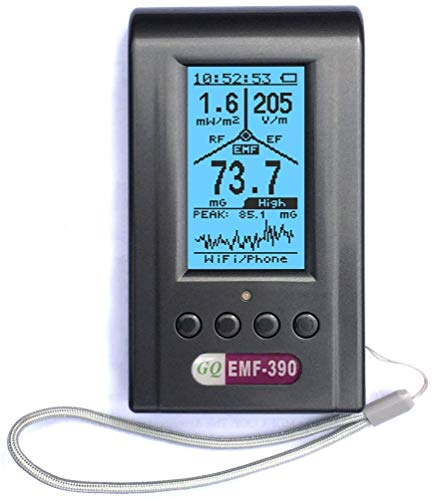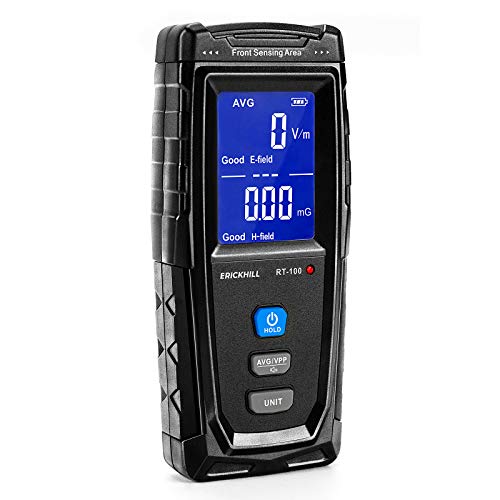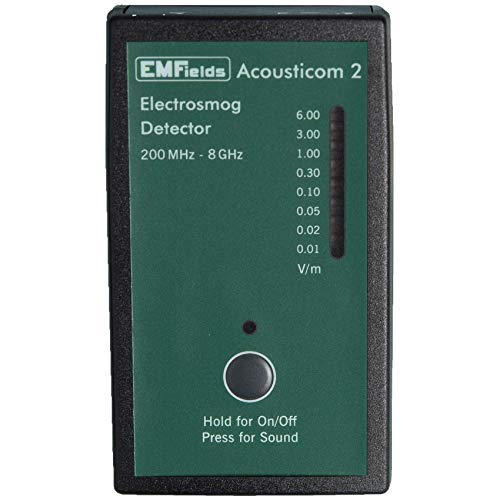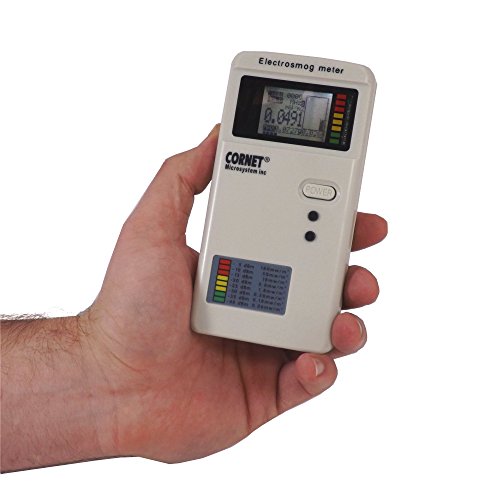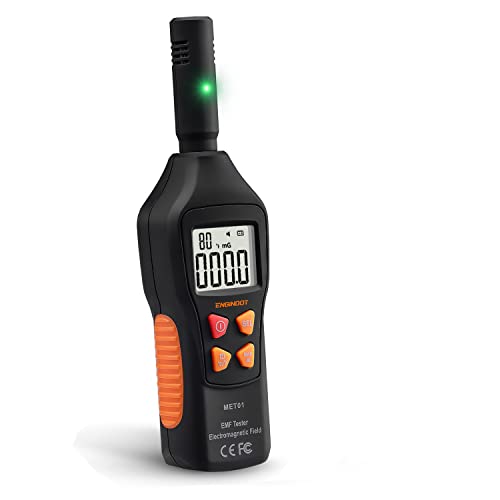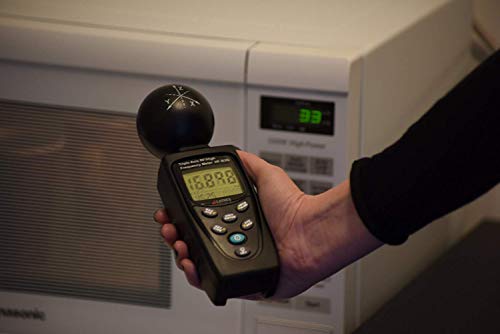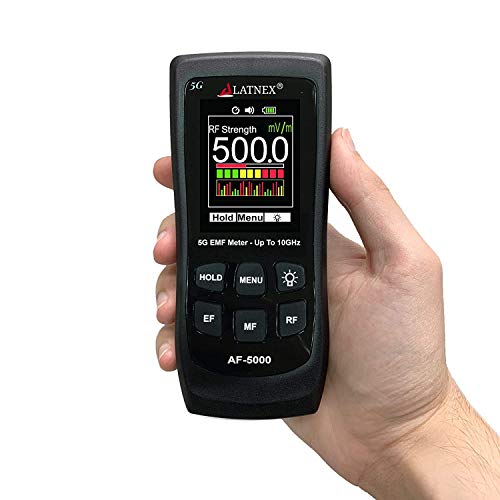As an affiliate, I may collect a share of sales or other compensation from the links on this page.
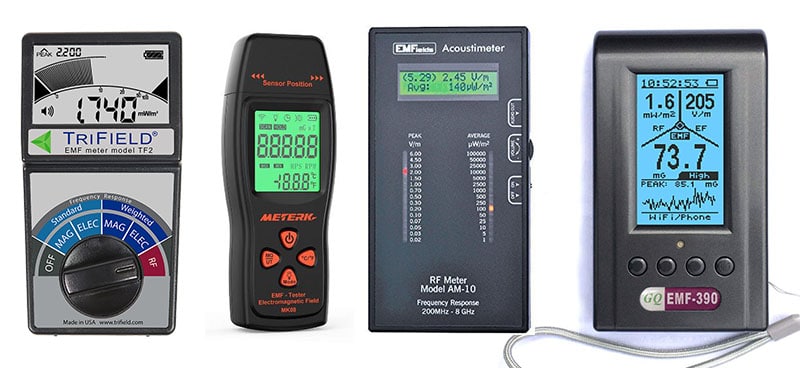
EMF meters are used to detect electromagnetic fields and measure the strength of the fields in various environments. The meters can help you determine the levels of radiation from electronic devices in your home, office, or any other space.
Best EMF Meters & Detectors
After a lot of research and testing, I have come up with a list of the best EMF detectors and meters (all linking to Amazon) and they are listed below in the table. RF stands for ‘Radio Frequency‘, EF for ‘Electric Fields‘ (ELF) and MF for ‘Magnetic Field‘.
| EMF Meter | Frequency Range | Detection | Budget | |
|---|---|---|---|---|
| 1. | Trifield TF2 | 20 Hz – 6 GHz | EF, MF, RF | Mid |
| 2. | Advanced GQ EMF-390 | 5 Hz – 10 GHz | EF, MF, RF | Mid |
| 3. | Erichill EMF Meter | 50 Hz – 3.5 GHz | EF, MF, RF | Low |
| 4. | Acousticom 2 RF Detector | 200 MHz – 8 GHz | RF | Mid |
| 5. | Acoustimeter RF Meter AM-10 | 200 MHz – 8 GHz | RF | High |
| 6. | Cornet ED-88T | 100 MHz – 8 GHz, 50 Hz – 10 kHz (LF) | EF, MF, RF | Mid |
| 7. | Engindot EMF Meter | 30 Hz – 300 Hz (LF), 2.4 GHz (RF) | EF, MF, RF | Low |
| 8. | Latnex HF-B3G | 3 MHz – 3.5 GHz | RF | Mid |
| 9. | Latnex AF-5000 | 10 MHz – 8 GHz | RF | High |
1. TriField EMF TF2
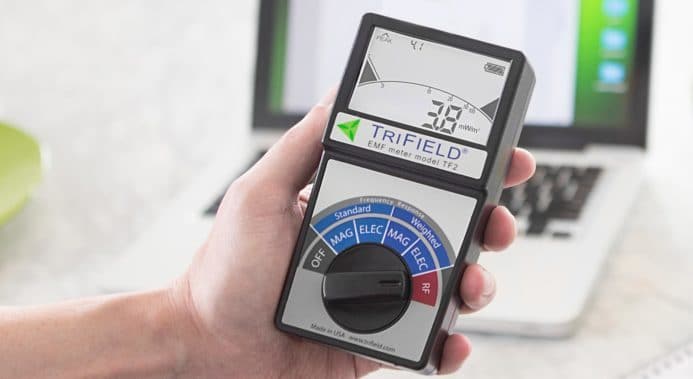
Distinguishing features of the TriField EMF TF2
- The Trifield TF2 is the best EMF meter which can read different types of EMF pollution, including magnetic, RF, and electric (a tri field meter as the name suggests).
- The EMF meter is easy to use, even for beginners.
- The 3-axis sensor allows for accurate readings from any direction, making it a versatile option for both personal and professional use.
Here is a video demonstrating the TF2 in action.
I personally tested the TF2 in various environments, such as my home office and outdoors near power lines, and found it to be very reliable and accurate in detecting EMF pollution.
Pros
- The Trifield TF2 measures magnetic fields, electric fields, and radio/microwave fields in a single EMF meter.
- It has a digital display that measures all three fields.
- It can detect extremely low-frequency magnetic fields, which are associated with power lines and appliances.
- The Trifield TF2 has a sound feature that allows you to hear changes in the magnetic field radiation.
- It has a tri-axial sensor, which means it can detect EMFs from any angle.
- The Trifield TF2 comes with a 1-year manufacturer’s warranty.
Cons
- The Trifield TF2 is relatively expensive compared to other EMF meters on the market.
- Some customers have reported that the sound feature can be difficult to hear in noisy environments.
- The instructions that come with the EMF reader may be difficult to understand for some users.
- Some customers have reported that the accuracy of the Trifield TF2 may be affected by interference from other electronics or metal objects in the area.
2. Advanced GQ EMF-390
Distinguishing features of the Advanced GQ EMF-390
- During my testing, I found that this EMF meter can measure various appliances and EMF levels from cell phones, cell towers, and power lines.
- The built-in memory allows for easy access to previous data, and you can download data to your computer for free.
- The compact and lightweight design, along with its USB port and ability to connect headphones or a microphone, make it convenient to use on the go.
Pros
- The EMF-390 can measure EMF radiation from 10MHz to 10GHz, making it suitable for measuring a wide range of sources, including Wi-Fi, cell phone signals, and microwave ovens.
- The EMF reader uses a triaxial measurement sensor, which provides more reliability than single-axis sensors commonly found in other meters.
- The EMF-390 has a large LCD screen that displays all the information you need, making it easy to read and understand the readings.
- The radio frequency meter has multiple functions, including measuring electric field, magnetic field, and RF radiation, making it a versatile tool for measuring electromagnetic radiation.
Cons
- The EMF-390 is more expensive than some other meters on the market, making it less accessible for those on a tight budget.
- The EMF meter has a limited battery life, and the rechargeable batteries must be replaced after a few years, which can be inconvenient.
- Some users have reported that the meter can sometimes produce noisy or erratic readings, which can be frustrating and make it difficult to interpret the data.
- The EMF-390 has a limited range of detection, which may not be sufficient for some applications, such as measuring EMF radiation from high-power sources or over long distances.
3. Erichill EMF Meter
Distinguishing features of the Erichill EMF Meter
- The Erickhill EMF Meter is a budget-friendly EMF detector with a lot of features
- Some key features found in more expensive models may be missing
- It’s a great option for those who are just starting to explore EMF detection.
Pros
- The ERICKHILL EMF Meter can measure electromagnetic radiation from 5Hz to 3500MHz, making it suitable for measuring a wide range of sources, including Wi-Fi, cell phone signals, and microwave ovens.
- I found this EMF reader easy to use, with a simple interface and straightforward controls.
- The ERICKHILL EMF Meter is small and lightweight, making it easy to carry around and use on the go.
- The EMF reader has multiple functions, including measuring electric field, magnetic field, and RF radiation, making it a versatile tool for measuring electromagnetic radiation.
- The ERICKHILL EMF Meter is one of the most affordable EMF meters on the market, making it accessible for those on a tight budget.
Cons
- The ERICKHILL EMF Meter has limited features compared to some other EMF meters, with no ability to measure specific frequency bands or types of radiation.
- The EMF reader has a limited range of detection, which may not be sufficient for some applications, such as measuring EMF radiation from high-power sources or over long distances.
- Some users have reported that the EMF meter may not provide the most reliable measurements, which can be a concern for those who need precise EMF measurements.
- The EMF meter has a limited battery life, and the rechargeable batteries must be replaced after a few years, which can be inconvenient.
4. Acousticom 2 RF Detector
Distinguishing features of the Acousticom 2 RF Detector
- This RF meter is affordable and easy to use, even for non-professionals.
- It has a detection range of 200MHz up to 8GHz and I could detect microwave leaks, Wi-Fi radiation, and cellular EMF levels while testing it.
- It has excellent customer ratings worldwide and comes with a 2-year warranty period for added peace of mind.
Pros
- The Acousticom 2 is small and lightweight, making it easy to carry around and use on the go.
- The EMF reader is easy to use, with a simple interface and straightforward controls.
- The Acousticom 2 can measure RF radiation from 200 MHz to 8 GHz, making it suitable for measuring a wide range of sources, including cell phone towers, Wi-Fi, and microwave ovens.
- The EMF meter has a long battery life, with a single 9-volt battery lasting up to 20 hours of continuous use.
Cons
- The Acousticom 2 has limited features compared to some other EMF detectors, with no ability to measure magnetic fields or electric fields.
- The device has a limited range of detection, which may not be sufficient for some applications, such as measuring EMF radiation from high-power sources or over long distances.
- Some users have reported that the EMF reader can sometimes produce noisy or erratic readings, which can be frustrating and make it difficult to interpret the data.
- The Acousticom 2 is more expensive than some other EMF detectors on the market, making it less accessible for those on a tight budget.
5. Acoustimeter RF Meter AM-10
Distinguishing features of the Acoustimeter AM-10
- As a user of the Acoustimeter AM-10, I can attest to its effectiveness in detecting a wide range of radio frequency (RF) radiation sources.
- This EMF meter has an audible alarm to help locate hot spots, and its wide range can read weak signals, including your neighbor’s radiation levels.
- The easy-to-read display and audio jack make it suitable for use in different environments, including low-light conditions.
Pros
- The Acoustimeter AM-10 can measure RF radiation from 200 MHz to 8 GHz, making it suitable for measuring a wide range of sources, including cell phone towers, Wi-Fi, and microwave ovens.
- The EMF reader uses a logarithmic display, which provides more accuracy than linear displays commonly found in other meters.
- The AM-10 has a large LCD screen that displays all the information you need, making it easy to read and understand the readings.
- The EMF detector has multiple features, including a sound output that allows you to hear the intensity of the radiation, making it a versatile tool for measuring electromagnetic radiation.
Cons
- The EMF reader has a limited battery life, and the rechargeable batteries must be replaced after a few years, which can be inconvenient.
- The AM-10 has a limited range of detection, which may not be sufficient for some applications, such as measuring EMF radiation from high-power sources or over long distances.
- The AM-10 is more expensive than some other RF meters on the market, making it less accessible for those on a tight budget.
- Some users have reported that the EMF reader can sometimes produce noisy or erratic readings, which can be frustrating and make it difficult to interpret the data.
6. CORNET ED-88T
Distinguishing features of the CORNET ED-88T
- I found this EMF meter to be affordable and convenient, suitable for both home and professional use.
- It has a wide range frequency of 100MHz to 8GHz and features a built-in memory for easy access to previous readings.
- The easy-to-use design, comfortable grip, and factory calibration provide accurate and reliable results.
Pros
- The ED-88T can measure electromagnetic radiation from 100MHz to 8GHz, making it suitable for measuring a wide range of sources, including Wi-Fi, cell phone signals, and microwave ovens.
- The EMF reader uses a triaxial measurement sensor, which provides more accuracy than single-axis sensors commonly found in other meters.
- The ED-88T has a large LCD screen that displays all the information you need, making it easy to read and understand the readings.
- The EMF meter has multiple functions, including measuring electric fields, and magnetic fields. It also measures RF radiation, making it a versatile tool for measuring electromagnetic radiation.
Cons
- The EMF meter has a limited battery life, and the rechargeable batteries must be replaced after a few years, which can be inconvenient.
- The ED-88T is more expensive than some other meters on the market, making it less accessible for those on a tight budget.
- The ED-88T has a limited range of detection, which may not be sufficient for some applications, such as measuring EMF radiation from high-power sources or over long distances.
- Some users have reported that the EMF reader can sometimes produce noisy or erratic readings, which can be frustrating and make it difficult to interpret the data.
7. Engindot EMF Meter
Distinguishing features of the Engindot EMF Meter
- The Erickhill EMF Meter is an affordable option for measuring electromagnetic fields.
- Its ergonomic design and high precision makes it easy to use and accurate in readings.
- I could test magnetic fields from 200mG to 2000mG and electric field radiation from 50V/m to 1000V/m making this meter ideal for residential use.
Pros
- The Engindot EMF Meter is one of the most affordable EMF meters on the market, making it accessible for those on a tight budget.
- The EMF meter is easy to use, with a simple interface and straightforward controls.
- The Engindot EMF Meter can measure electromagnetic radiation from 50MHz to 3.5GHz, making it suitable for measuring a wide range of sources, including Wi-Fi, cell phone signals, and microwave ovens.
- The Engindot EMF Meter is small and lightweight, making it easy to carry around and use on the go.
Cons
- The Engindot EMF Meter has limited features compared to some other EMF meters, with no ability to measure magnetic fields or electric fields.
- The EMF reader has a limited range of detection, which may not be sufficient for some applications, such as measuring EMF radiation from high-power sources or over long distances.
- Some users have reported that the meter may not provide the most accuracy, which can be a concern for those who need precise EMF measurements.
- The EMF meter has a limited battery life, and the rechargeable batteries must be replaced after a few years, which can be inconvenient.
8. Latnex HF-B3G
Distinguishing features of the Latnex HF-B3G
- During my testing, I found the Latnex HF-B3G to be a reliable EMF detector with an easy-to-read display that shows peak readings in μW/m² or mW/m².
- It uses an isotropic triaxial sensor to detect electromagnetic waves from all directions and measures from 50MHz to 3.5GHz.
- The EMF meter is portable, convenient, and has a long battery life. Regular calibration and additional protective gear can help reduce EMF exposure to harmful EMF radiation.
Pros
- The HF-B3G can measure electromagnetic radiation from 50MHz to 3.5GHz, making it suitable for measuring a wide range of sources, including Wi-Fi, cell phone signals, and microwave ovens.
- The EMF meter uses a triaxial measurement sensor, which provides more accuracy than single-axis sensors commonly found in other meters.
- The HF-B3G has a large LCD screen that displays all the information you need, making it easy to read and understand the readings.
- The EMF meter has multiple functions, including measuring electric field, magnetic field, and radio frequency radiation, making it a versatile tool for measuring electromagnetic radiation.
Cons
- The HF-B3G is more expensive than some other meters on the market, making it less accessible for those on a tight budget.
- The device has a limited battery life, and the rechargeable batteries must be replaced after a few years, which can be inconvenient.
- Some users have reported that the device can sometimes produce noisy or erratic readings, which can be frustrating and make it difficult to interpret the data.
- The HF-B3G has a limited range of detection, which may not be sufficient for some applications, such as measuring EMF radiation from high-power sources or over long distances.
9. Latnex AF-5000
Distinguishing features of the Latnex AF-5000
- The Latnex AF-5000 is a reliable and accurate EMF meter designed for residential, workplace, and industrial environments.
- Its wide range of measurement from 10Hz up to 8GHz makes it suitable for a variety of applications.
- The optional GPS function helps identify the location where EMF measurements are taken.
- It’s easy to use and can help protect you and your family from potentially harmful and invisible electromagnetic fields.
Pros
- The AF-5000 can measure electromagnetic radiation from 1MHz to 10GHz, making it suitable for measuring a wide range of sources, including Wi-Fi, cell phone signals, and microwave ovens.
- The device uses a triaxial measurement sensor, which provides more accuracy than single-axis sensors commonly found in other meters.
- The AF-5000 has a large LCD screen that displays all the information you need, making it easy to read and understand the readings.
- The EMF meter has multiple functions, including measuring electric field, magnetic field, and RF radiation, making it a versatile tool for measuring electromagnetic radiation.
Cons
- The AF-5000 is more expensive than some other meters on the market, making it less accessible for those on a tight budget.
- The device has a limited battery life, and the rechargeable batteries must be replaced after a few years, which can be inconvenient.
- Some users have reported that the device can sometimes produce noisy or erratic readings, which can be frustrating and make it difficult to interpret the data.
- The AF-5000 has a limited range of detection, which may not be sufficient for some applications, such as measuring radiation from high-power sources or over long distances.
Choosing the Right EMF Meter: Key Decision-Making Factors and Design Choices
When selecting the best EMF meter for your needs, it’s essential to consider key decision-making factors and understand how design choices impact the user experience.
Here, we delve deeper into these aspects to help you make a more informed decision.
Decision-Making Factors
- Detection Range and Sensitivity: EMF meters vary in their detection range and sensitivity to different types of electromagnetic fields. Look for a meter that covers the frequency range relevant to your needs and offers the required sensitivity to detect the EMF levels you’re interested in measuring.
- Accuracy and Reliability: An accurate and reliable meter is crucial for obtaining meaningful measurements. Consider devices with a good reputation for precision and consistency, and check for customer reviews and testimonials to support these claims.
- Ease of Use: A user-friendly interface, simple controls, and clear instructions make it easier for both beginners and experienced users to operate the device effectively. Look for devices that are easy to set up, read, and interpret the data.
- Price: EMF meters are available at various price points, from budget-friendly options to high-end professional meters. Determine your budget and select a device that offers the best value for money without compromising on quality and features.
Design Choices and Impact on User Experience
- Sensor Type: The choice between a triaxial sensor and a single-axis sensor can significantly impact the accuracy and convenience of an EMF meter. Triaxial sensors detect EMFs from any angle, while single-axis sensors require proper orientation to obtain accurate readings. Triaxial sensors generally provide more reliable measurements and are easier to use.
- Display: Analog displays may be more affordable, but digital displays provide better readability and precision. A backlit digital display can also be helpful for use in low-light conditions.
- User Interface: A well-designed user interface enhances the overall user experience. Look for devices with intuitive menu navigation, clear labeling of buttons, and the ability to switch between different modes or units easily.
- Additional Features: Innovative features like data logging, smartphone app integration, or advanced filtering options can set a device apart from its competitors. These features can offer added convenience and functionality, but also consider if these features are essential for your specific needs.
By considering these key decision-making factors and understanding the impact of design choices on user experience, you can make a more informed decision when selecting the right EMF meter for your needs.
Remember to read customer reviews and testimonials to get a better understanding of how well each product performs in real-life situations.
References:
- https://www.trifield.com/wp-content/uploads/2022/01/TF2OwnersManual.pdf
- https://www.admnucleartechnologies.com.au/blog/guide-buying-emf-meter
- https://www.globalspec.com/learnmore/sensors_transducers_detectors/electrical_electromagnetic_sensing/emf_meters
- https://dl.cdn-anritsu.com/en-us/test-measurement/files/Manuals/Measurement-Guide/10580-00489A.pdf
